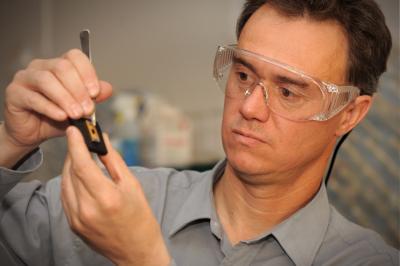Nanotechnology holds big potential for NMSU faculty

"One nanometer is about 10,000 times thinner than a hair," said Martinez, a chemical engineering assistant professor. "Those are the dimensions of the materials that my group works with to develop new research. Our research involves the use of advanced fabrication and characterization tools to understand the novel properties of nanostructured materials.
"We use nanomanipulation to essentially pick individual nanowires and place them in our devices. One example of nanotechnology application is converting heat into electricity by highly efficient thermoelectric materials."
Martinez explained that when heat is applied to thermoelectric materials, electric power is produced. The amount of electricity generated depends on how much heat is applied and the efficiency of the material to convert heat into electricity. That amount increases at the nano-level.
"Ten years ago, physicists developed a new theoretical framework for thermoelectrics," he said. "They found that nanostructured materials would drastically increase the thermoelectric efficiency."
Thermoelectrics can, for example, convert the heat waste from a car engine's tailpipe into electricity, thus improving gas mileage. The engine would work with the gas and the thermoelectric component would charge the battery.
"Nanowires are perhaps the best example of how to get high efficiency thermoelectric materials," Martinez said. In addition to energy harvesting, thermoelectric nanostructured materials can assist in cooling high power transistors.
Although he first began working with silicon nanowires at Livermore National Laboratory, Martinez has since moved on to experimenting with gallium nitride, which has better characteristics for computer chip applications, and silicon-germanium alloy nanowires. Silicon, he explained, works well for electronics but is "limited by its thermoelectric efficiency."
Martinez also helped in the construction of the nanomanipulator as a thermoelectric testing tool. Already in development at Sandia National Laboratories, Martinez helped fine-tune it to suit his needs.
"It's a superb research tool," he said. "You can do research that can be translated and applied. Applicable research is what I'm really excited about. The results you get can lead to larger-scale applications.
"Nanomanipulation is not an issue at all," he added. "When you're measuring thermoelectric properties, you need to understand how to improve the contacts between nanowires and the electrical devices. Due to the size of the material we're working with, contact is challenging, but we are making significant progress. If you're working in large scale applications, for example, the contact limitations that you have for one nanowire, you're now going to have for a million nanowires."
A native of Buenos Aires, Martinez earned his bachelor's degree from the National Technological University in Argentina and his master's from Mississippi State University, where he became interested in nanotechnology. He obtained his doctorate from the University of California-Davis/Lawrence Livermore National Laboratory.
NASA is supporting one of his projects in thermoelectrics.
Martinez is the recipient of the 2003 Honda-Barrier Fellowship and the Lawrence Scholar from Livermore National Laboratory in 2005.
Before joining the NMSU faculty in spring 2013, he worked at the Center for Integrated Nanotechnologies at Sandia National Laboratories, N.M.
His goal, he said, is "to improve the outlook of some of the emerging issues we are facing as a society."


